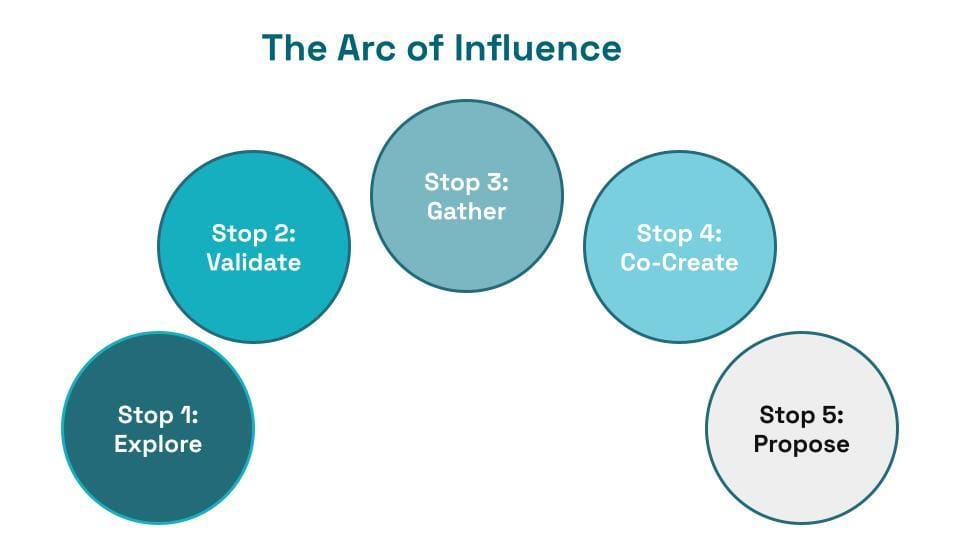- The Next Steps: Lead InStride
- Posts
- The Arc of Influence: Persistence After No
The Arc of Influence: Persistence After No
How leaders move past “no” without force or frustration
TL;DR: A “no” at work is rarely final. It often means overwhelm or poor timing, not rejection. Treat “no” as the start of the Arc of Influence: pause, explore, validate, gather evidence, co-create, then propose. Influence comes through persistence and curiosity, not quick wins. A “no” is the beginning of influence.
One of the toughest moments in any career is asking for something and hearing a clear “no.” It might be a request to collaborate, a recommendation to your boss, or an idea that could make the company (and your job) run better.
And yet: a flat “no.” Full stop.
Some people gripe and cause a stink. Some people shrug it off and back away. Both may think:
“I’m not paid enough to deal with this.”
“This isn’t my problem to fix.”
“Idiots! Do they not see what I am telling them?”
“If I keep pushing, I’ll just annoy someone.”
When we stop, nothing moves. Our thinking loops. Their problems persist. Everyone loses.
What “No” Really Means
Why do people say “no”? Usually, it is not about you. They are overwhelmed. The problem feels too big, too complicated, too costly to get truly curious. Sometimes they do not even see the problem.
Take one of my clients. He kept proposing solutions at work and leadership would shut him down. From the leadership’s perspective, “no” was likely protection. If everything seemed to be running smoothly, why invite disruption?
But from my client’s perspective, “no” felt like dismissal. Describing how he felt about it, he would become quiet. He would blame himself: wrong words, wrong timing, not enough credibility.
Far too often we take “no” as something personal. But what if “no” was simply a signal to reframe, slow down, and get curious?
The Arc of Influence
We all love the rare moment when we make our ask and get a quick yes. That is luck.
Influence rarely happens in one shot. It is persistence. If you recently got a “no” at work, first find where you are on the the arc of influence.

Stop 1: Explore – As soon as you hear “no,” take a breath. Instead of immediately arguing or shrugging your shoulders, get curious. Ask questions. Your job is then to listen.
Stop 2: Validate – Bring what you have learned back to your team. Is this one person’s hesitation or a recurring barrier? What is the cost of leaving it unsolved?
Stop 3: Gather Evidence – Get it all down in writing. A memo or slide doc. Keep it objective: the problem, the risks, the benefits. Avoid personalities.
Stop 4: Co-Create – Share the memo or slide doc before the meeting and ask for comments and feedback. With those comments, sharpen your case and frame the solution from the stakeholder’s point of view. Simply put: if you show them how they can benefit from resolving the problem, they are more likely to say “yes.”
Stop 5: Propose – Present it clearly: the problem, the recommendation, the result of acting or not from their point of view. Then ask: “How can we solve this together?”
Hot Tip: In your next team meeting or 1:1 with your manager, share the Arc of Influence and explain how you plan to use it. Ask for advice on where to start or how to strengthen your next move.
Final Takeaway
A “no” is not a dead end.
In my client’s case, the next time he encountered a “no,” he started small. He tested his ideas in low-stakes settings, refined them with the help of his team, and documented results. Only then did he bring leadership a fully formed proposal.
Later he told me:
“The problems I find at work are so obvious to me. I had no idea how much work it would take to help people see things like I do. What used to feel like a swift kick to the stomach when hearing a ‘no,’ now feels like an invitation to stand up taller.”
The real work of influence is not quick wins. It is persistence. And persistence is what turns “no” into “yes.”

If you want 1:1 leadership coaching on how to navigate challenges at work, build influence, and move your career forward with more clarity and confidence, reach out at [email protected]. Visit leadinstride.com to learn more.
Reply